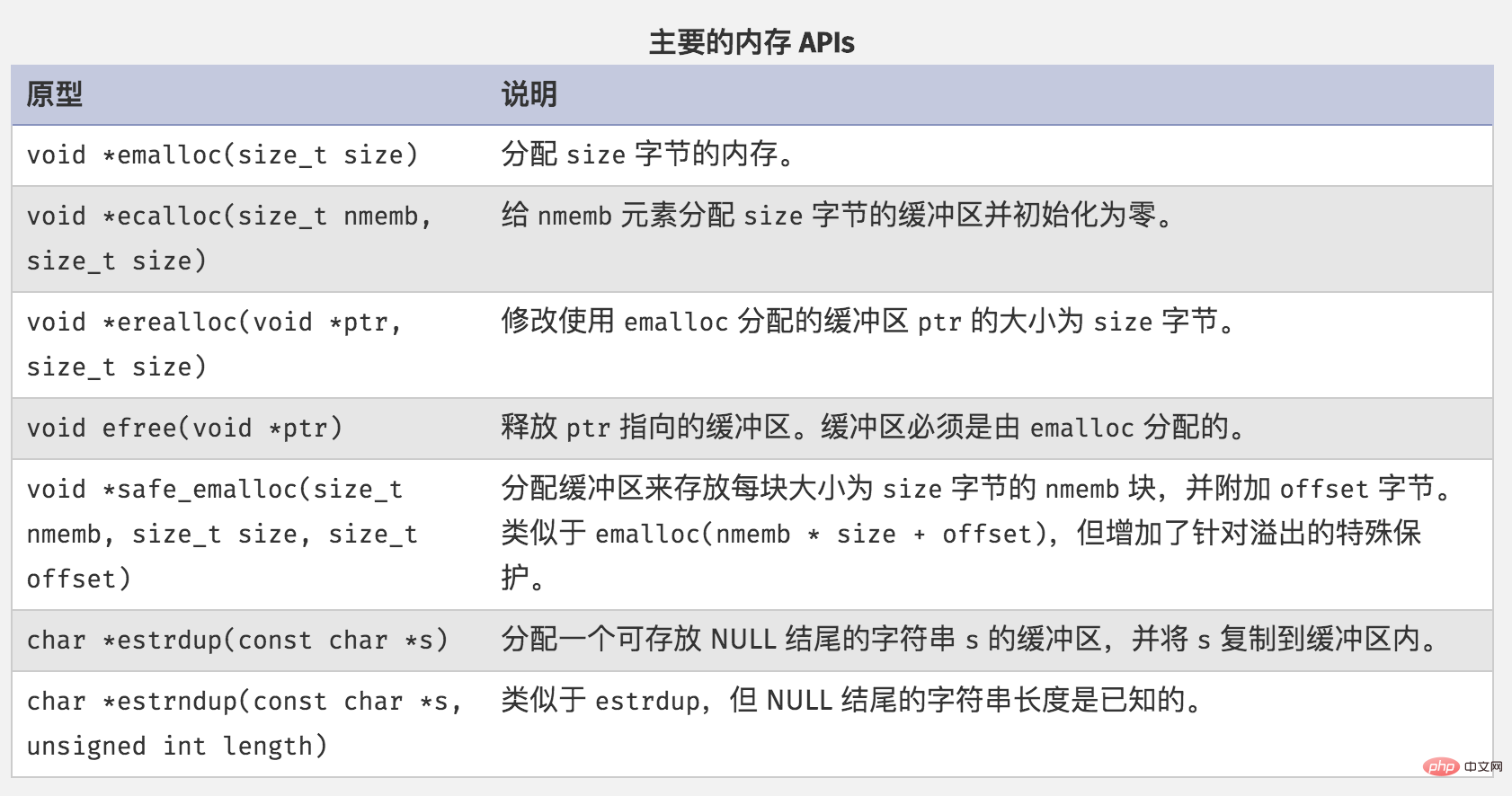Let's talk about thoughts about PHP memory overflow

When doing large-scale data export and data import recently, I often encounter the problem of PHP memory overflow. After solving the problem, I summarized some experiences and compiled them into articles to record. .
Optimization points
Optimize SQL statements, avoid slow queries, build indexes reasonably, and query specified fields. SQL optimization will not be discussed here.
When the query result set is a large object, it is converted to an array. There are generally methods in the framework to convert, such as toArray() in Laravel and asArray() in Yii2.
For data cutting of large arrays, PHP functions include array_chunk() and array_slice().
For large strings and objects, use &.
Used variables are unset in time.
The exported file format is changed from excel to csv
ini_set('memory_limit',''), set the memory that the program can use ( Not recommended).
Thinking
Memory Management
How to manage the memory of PHP? When learning C language, developers need to manually manage memory. In PHP, the Zend engine provides a special memory manager for processing request-related data. Requesting related data only requires serving a single request, and the data will be released at the end of the request at the latest.

The above picture is a description screenshot from the official website
Preventing memory leaks and releasing all memory as quickly as possible is an important part of memory management. For security reasons, Zend Engine will release all memory allocated by the API lock mentioned above.
Garbage collection mechanism
A brief explanation:
Before PHP5.3, reference counting was used for management. Variables in PHP are stored in the variable container of zval. When a variable is referenced, the reference count is 1. When the variable reference count is 0, PHP will destroy the variable in memory. However, when the reference count is cyclically referenced, the reference count will not be reduced to 0, causing a memory leak.
After PHP5.3, optimization has been done. It does not enter the recycling cycle every time the reference count decreases. Garbage collection starts only after the root buffer is full. This can solve the problem of circular references and can also restore the total Memory leaks remain below a threshold.
Code
Since memory overflow is often encountered when using phpexcel, here is a code to generate a csv file:
<?php
namespace api\service;
class ExportService
{
public static $outPutFile = '';
/**
* 导出文件
* @param string $fileName
* @param $data
* @param array $formFields
* @return mixed
*/
public static function exportData($fileName = '', $data, $formFields = [])
{
$fileArr = [];
$tmpPath = \Yii::$app->params['excelSavePath'];
foreach (array_chunk($data, 10000) as $key => $value) {
self::$outPutFile = '';
$subject = !empty($fileName) ? $fileName : 'data_';
$subject .= date('YmdHis');
if (empty($value) || empty($formFields)) {
continue;
}
self::$outPutFile = $tmpPath . $subject . $key . '.csv';
if (!file_exists(self::$outPutFile)) {
touch(self::$outPutFile);
}
$index = array_keys($formFields);
$header = array_values($formFields);
self::outPut($header);
foreach ($value as $k => $v) {
$tmpData = [];
foreach ($index as $item) {
$tmpData[] = isset($v[$item]) ? $v[$item] : '';
}
self::outPut($tmpData);
}
$fileArr[] = self::$outPutFile;
}
$zipFile = $tmpPath . $fileName . date('YmdHi') . '.zip';
$zipRes = self::zipFile($fileArr, $zipFile);
return $zipRes;
}
/**
* 向文件写入数据
* @param array $data
*/
public static function outPut($data = [])
{
if (is_array($data) && !empty($data)) {
$data = implode(',', $data);
file_put_contents(self::$outPutFile, iconv("UTF-8", "GB2312//IGNORE", $data) . PHP_EOL, FILE_APPEND);
}
}
/**
* 压缩文件
* @param $sourceFile
* @param $distFile
* @return mixed
*/
public static function zipFile($sourceFile, $distFile)
{
$zip = new \ZipArchive();
if ($zip->open($distFile, \ZipArchive::CREATE) !== true) {
return $sourceFile;
}
$zip->open($distFile, \ZipArchive::CREATE);
foreach ($sourceFile as $file) {
$fileContent = file_get_contents($file);
$file = iconv('utf-8', 'GBK', basename($file));
$zip->addFromString($file, $fileContent);
}
$zip->close();
return $distFile;
}
/**
* 下载文件
* @param $filePath
* @param $fileName
*/
public static function download($filePath, $fileName)
{
if (!file_exists($filePath . $fileName)) {
header('HTTP/1.1 404 NOT FOUND');
} else {
//以只读和二进制模式打开文件
$file = fopen($filePath . $fileName, "rb");
//告诉浏览器这是一个文件流格式的文件
Header("Content-type: application/octet-stream");
//请求范围的度量单位
Header("Accept-Ranges: bytes");
//Content-Length是指定包含于请求或响应中数据的字节长度
Header("Accept-Length: " . filesize($filePath . $fileName));
//用来告诉浏览器,文件是可以当做附件被下载,下载后的文件名称为$file_name该变量的值
Header("Content-Disposition: attachment; filename=" . $fileName);
//读取文件内容并直接输出到浏览器
echo fread($file, filesize($filePath . $fileName));
fclose($file);
exit();
}
}
}Calling out the code
$fileName = "库存导入模板";
$stockRes = []; // 导出的数据
$formFields = [
'store_id' => '门店ID',
'storeName' => '门店名称',
'sku' => 'SKU编码',
'name' => 'SKU名称',
'stock' => '库存',
'reason' => '原因'
];
$fileRes = ExportService::exportData($fileName, $stockRes, $formFields);
$tmpPath = \Yii::$app->params['excelSavePath']; // 文件路径
$fileName = str_replace($tmpPath, '', $fileRes);
// 下载文件
ExportService::download($tmpPath, $fileName);Recommended learning: PHP video tutorial
The above is the detailed content of Let's talk about thoughts about PHP memory overflow. For more information, please follow other related articles on the PHP Chinese website!

Hot AI Tools

Undresser.AI Undress
AI-powered app for creating realistic nude photos

AI Clothes Remover
Online AI tool for removing clothes from photos.

Undress AI Tool
Undress images for free

Clothoff.io
AI clothes remover

Video Face Swap
Swap faces in any video effortlessly with our completely free AI face swap tool!

Hot Article

Hot Tools

Notepad++7.3.1
Easy-to-use and free code editor

SublimeText3 Chinese version
Chinese version, very easy to use

Zend Studio 13.0.1
Powerful PHP integrated development environment

Dreamweaver CS6
Visual web development tools

SublimeText3 Mac version
God-level code editing software (SublimeText3)

Hot Topics
 1663
1663
 14
14
 1419
1419
 52
52
 1313
1313
 25
25
 1263
1263
 29
29
 1236
1236
 24
24
 How do you parse and process HTML/XML in PHP?
Feb 07, 2025 am 11:57 AM
How do you parse and process HTML/XML in PHP?
Feb 07, 2025 am 11:57 AM
This tutorial demonstrates how to efficiently process XML documents using PHP. XML (eXtensible Markup Language) is a versatile text-based markup language designed for both human readability and machine parsing. It's commonly used for data storage an
 Explain JSON Web Tokens (JWT) and their use case in PHP APIs.
Apr 05, 2025 am 12:04 AM
Explain JSON Web Tokens (JWT) and their use case in PHP APIs.
Apr 05, 2025 am 12:04 AM
JWT is an open standard based on JSON, used to securely transmit information between parties, mainly for identity authentication and information exchange. 1. JWT consists of three parts: Header, Payload and Signature. 2. The working principle of JWT includes three steps: generating JWT, verifying JWT and parsing Payload. 3. When using JWT for authentication in PHP, JWT can be generated and verified, and user role and permission information can be included in advanced usage. 4. Common errors include signature verification failure, token expiration, and payload oversized. Debugging skills include using debugging tools and logging. 5. Performance optimization and best practices include using appropriate signature algorithms, setting validity periods reasonably,
 Explain late static binding in PHP (static::).
Apr 03, 2025 am 12:04 AM
Explain late static binding in PHP (static::).
Apr 03, 2025 am 12:04 AM
Static binding (static::) implements late static binding (LSB) in PHP, allowing calling classes to be referenced in static contexts rather than defining classes. 1) The parsing process is performed at runtime, 2) Look up the call class in the inheritance relationship, 3) It may bring performance overhead.
 PHP Program to Count Vowels in a String
Feb 07, 2025 pm 12:12 PM
PHP Program to Count Vowels in a String
Feb 07, 2025 pm 12:12 PM
A string is a sequence of characters, including letters, numbers, and symbols. This tutorial will learn how to calculate the number of vowels in a given string in PHP using different methods. The vowels in English are a, e, i, o, u, and they can be uppercase or lowercase. What is a vowel? Vowels are alphabetic characters that represent a specific pronunciation. There are five vowels in English, including uppercase and lowercase: a, e, i, o, u Example 1 Input: String = "Tutorialspoint" Output: 6 explain The vowels in the string "Tutorialspoint" are u, o, i, a, o, i. There are 6 yuan in total
 What are PHP magic methods (__construct, __destruct, __call, __get, __set, etc.) and provide use cases?
Apr 03, 2025 am 12:03 AM
What are PHP magic methods (__construct, __destruct, __call, __get, __set, etc.) and provide use cases?
Apr 03, 2025 am 12:03 AM
What are the magic methods of PHP? PHP's magic methods include: 1.\_\_construct, used to initialize objects; 2.\_\_destruct, used to clean up resources; 3.\_\_call, handle non-existent method calls; 4.\_\_get, implement dynamic attribute access; 5.\_\_set, implement dynamic attribute settings. These methods are automatically called in certain situations, improving code flexibility and efficiency.
 PHP and Python: Comparing Two Popular Programming Languages
Apr 14, 2025 am 12:13 AM
PHP and Python: Comparing Two Popular Programming Languages
Apr 14, 2025 am 12:13 AM
PHP and Python each have their own advantages, and choose according to project requirements. 1.PHP is suitable for web development, especially for rapid development and maintenance of websites. 2. Python is suitable for data science, machine learning and artificial intelligence, with concise syntax and suitable for beginners.
 PHP in Action: Real-World Examples and Applications
Apr 14, 2025 am 12:19 AM
PHP in Action: Real-World Examples and Applications
Apr 14, 2025 am 12:19 AM
PHP is widely used in e-commerce, content management systems and API development. 1) E-commerce: used for shopping cart function and payment processing. 2) Content management system: used for dynamic content generation and user management. 3) API development: used for RESTful API development and API security. Through performance optimization and best practices, the efficiency and maintainability of PHP applications are improved.
 PHP: A Key Language for Web Development
Apr 13, 2025 am 12:08 AM
PHP: A Key Language for Web Development
Apr 13, 2025 am 12:08 AM
PHP is a scripting language widely used on the server side, especially suitable for web development. 1.PHP can embed HTML, process HTTP requests and responses, and supports a variety of databases. 2.PHP is used to generate dynamic web content, process form data, access databases, etc., with strong community support and open source resources. 3. PHP is an interpreted language, and the execution process includes lexical analysis, grammatical analysis, compilation and execution. 4.PHP can be combined with MySQL for advanced applications such as user registration systems. 5. When debugging PHP, you can use functions such as error_reporting() and var_dump(). 6. Optimize PHP code to use caching mechanisms, optimize database queries and use built-in functions. 7




